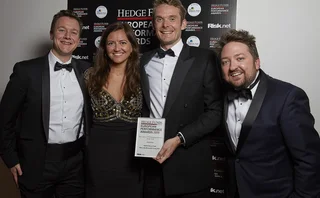
With merger mania, can short ever be sweet?
UK equity hedge fund managers believe private equity bid deal analysis holds the answer to working a short book in the current markets, says Solomon Teague
For most long/short hedge fund managers, running a short book remains the real challenge in their role, where the risk is significantly higher and potential gain limited - the inverse of the situation in a fund's long book.
In recent times the short book has become an even bigger headache for hedge fund managers, says Mike Nicol, portfolio manager of Glasgow Mackintosh's Pan European Long/Short Equity Fund.
private problems
The problem, he says, has come with private equity funds: where once managers made a judgement on which companies looked good as prospective shorts, this assessment has been complicated by concern a company that appears overpriced to most investors may look quite different to private equity companies. Private equity has been swooping for firms in many short books, causing prices to go against hedge fund managers, with calamitous consequences on returns in many instances, he explains.
"They have changed the game, changed the definition of expensive," he says.
The management style of Ross Hollyman, investment director and manager of the GAM UK Equity hedge fund, swims against the tide in this respect, using shorts aggressively to hedge out market exposure. The fund he oversees runs up to a 300% gross exposure, but only 30% net, giving it a beta of 0.56%.
It has become essential for hedge fund managers to pay close attention to private equity deals to ascertain where they set their benchmarks for valuations in different sectors, Nicol adds. He believes past deals give as accurate an indicator of where future deals will be struck as is available.
fundamental flaws
The old days of managers doggedly analysing price/earnings ratios as the principal indicator of equity value are gone, though fundamental analysis remains an important part of Glasgow Mackintosh's investment process.
"Avoiding private equity deals has become the short book's equivalent of avoiding profit warnings for the long book," says Hollyman. Worse, he adds, is the rumour mill, which drives equity prices without necessarily being backed up by fact.
Hollyman points out that private equity deals can be modelled with some success, though it is still important the manager monitors the risk in other ways. He adds that, essentially, it is a product of the stage of the cycle. Rumours and private equity deals are cyclical.
Glasgow Mackintosh's equity fund has delivered 9.12% since its launch in April 2006. It focuses on small- and mid-cap stocks and has a strong UK bias, this being the country where such companies have most liquidity, though over time it plans to extend its investments in Europe.
The firm takes a bottom-up approach to stock selection, with a team of five dividing the investment universe into sectors. Among those covered by Nicol are utilities, oils, tobacco and beverages. Sectors have different influences, he explains, and what may look good for a company in one sector may be poor in the context of another.
face to face
Visiting companies is key, Nicol says. Between the five portfolio managers of the fund, around 900 companies are visited each year. They want to analyse not only fundamentals but competition and supply lines.
A similar approach is taken at EEA Fund Management. The EEA Select Opportunities Fund (SOF) is notionally a European equities fund, managing a modest £6.5m, also investing principally in small- and mid-cap stocks, although it has in the past invested in some larger caps, for example Vodafone. Launched in May 2004, the fund has delivered 118% since inception and 9.61% year to date (as at May).
Small in size, the fund has yet to register on the institutional investor radar, although manager Paul Goacher hopes it will grow and attract such investors in time.
Currently it counts a number of hedge fund managers among its investors, he notes; people who would like to invest in the kinds of positions in which the EEA Select Opportunities Fund invests, but who are prevented because of the conflict it would cause with the management of their own hedge fund portfolios. In practice the fund has a strong bias towards UK companies, partly due to the higher liquidity in their smaller stocks.
EEA Select Opportunities Fund has the ability to take a long exposure of up to 120% but is currently around 80% long. An overall position of 50% net long would be considered low, says Goacher, who admits he uses shorting very sparingly. "You don't make money by being short," he says.
The firm utilises its short book primarily to ensure the portfolio is balanced and well hedged.
"We want a focused fund, with less than 20 long positions and between five and 10 shorts," says Goacher. It ensures its shorts are fewer than its longs. EEA Select Opportunities Fund, which is a bottom-up stock picker, looks for companies coming out of difficult times, with a good cashflow yield, in a company they understand, a sector with good growth potential and where the management own a significant stake.
It is not a pure value fund, but looks for "value with some momentum", with strong earnings a prerequisite to investment.
SOF believes in holding cash, with 14% of the portfolio currently in cash holdings. On the other hand, in its longs it is happy to build high-conviction positions up to a significant size: its largest single position is currently London Capital Group, a spread-betting firm, in which it has 9.11% of its entire net asset value invested.
Growth prospects
Half of London Capital's equity is held by three of its managers. Its business is compelling, with great growth prospects across Europe, especially as a result of the Markets in Financial Instruments Directive (MiFID), says Goacher.
An internet-based business, it has low costs and the potential to make lots of money, he says. Although its returns look a little low compared with some companies in its sector, Goacher says, it has avoided making any loans, so is at no risk of bad debts.
The firm's second largest holding is Staffline Recruitment, which specialises in recruitment for blue-collar industries, particularly with more Eastern European immigrants coming into the UK.
Goacher believes recruitment is a popular choice among money managers, but most have opted to take exposure to the white-collar sector, he says, while EEA believes that blue-collar demand will be strong and ensure the high performance in this position.
The Glasgow Mackintosh equity fund also has a long bias, and although with the ability to go net short by 25% it is, on average, 50% net long.
Ideally the fund looks to have around 40 positions each in its long and short books, though typically with smaller short positions, reflecting extra risk on these trades.
Glasgow Mackintosh had a short position in Trinity Mirror from which it profited, says Nicol. Advertising revenue in the publishing business is evolving quickly, he notes, with traditional streams giving way to the increasingly important online business model. Trinity Mirror was struggling to keep up with this trend, Nicol explains, which marked it out as a short.
The fund's average short position holding time is between three and six months, Nicol says, compared with its long positions, which it tends to hold for between six and 12 months. Nicol is a great believer in the importance of the long book. In a previous incarnation, as a portfolio manager at the Highlander Hedge Fund at SVM Asset Management (a role he held from 1998 to 2002), Nicol managed his way through the post-technology bubble bursting, delivering 16% while running his fund net long.
Although Glasgow Mackintosh managers cover separate sectors, the fund does not weight its positions according to their sectors, but according to their sensitivity to market movements.
Here it has two categories: economically sensitive holdings and defensive holdings.
When the market is in a bear run it is better to have defensive stocks, while when it is in a bull run it is better to weight the portfolio towards economically sensitive positions. From a risk management perspective, and because it is impossible to know what market condition is around the corner, the fund is always a carefully balanced blend of stocks from both groups.
From a portfolio diversification perspective, it is important to ensure stock selection reflects a number of different ideas, Nicol says. "Too often separate holdings are actually different plays on the same idea," he explains.
As with its stock selection, risk is viewed stock by stock, with the volatility of individual positions assessed to determine the risk of a whole portfolio, though a top-down view is also taken to ensure thorough risk analysis.
Only users who have a paid subscription or are part of a corporate subscription are able to print or copy content.
To access these options, along with all other subscription benefits, please contact info@risk.net or view our subscription options here: http://subscriptions.risk.net/subscribe
You are currently unable to print this content. Please contact info@risk.net to find out more.
You are currently unable to copy this content. Please contact info@risk.net to find out more.
Copyright Infopro Digital Limited. All rights reserved.
You may share this content using our article tools. Printing this content is for the sole use of the Authorised User (named subscriber), as outlined in our terms and conditions - https://www.infopro-insight.com/terms-conditions/insight-subscriptions/
If you would like to purchase additional rights please email info@risk.net
Copyright Infopro Digital Limited. All rights reserved.
You may share this content using our article tools. Copying this content is for the sole use of the Authorised User (named subscriber), as outlined in our terms and conditions - https://www.infopro-insight.com/terms-conditions/insight-subscriptions/
If you would like to purchase additional rights please email info@risk.net
More on Hedge funds
JP Morgan warns hedge funds to expect intraday margin calls
US bank may demand variation margin ‘up to seven’ times a day after Archegos default
Alternative markets give edge to Florin Court strategy
By concentrating on exotic and alternative markets, Florin Court Capital Fund has sidestepped overcrowding and correlation to the main trend following commodity trading advisers, offering investors a diversified alternative to the standard systemic macro…
Global macro views combine with quantitative models to produce consistent returns
The team behind River and Mercantile Group’s global macro strategy team operates under two key principles: that macro is the most important aspect of any investment decision and that decision-making should incorporate both systematic and discretionary…
On the offensive – Seeking a new edge, buy-side invests in portfolio and risk analytics
A fast-moving, headstrong hedge fund – hit by rare losses after a black swan event touched on an overweight country exposure – ponders adding fresh quantitative expertise. Much to traders’ chagrin, the chief investment officer and chief operating officer…
Esma backtracks on account segregation
Status quo protected for rehypothecation of collateral in tri-party, securities lending and prime brokerage
Redemptions focused within strategies suffering losses in 2016
Redemptions focused within strategies suffering losses in 2016
Hedge fund redemptions a dismal end to a bad year
Managed futures funds saw big inflows in 2016, but left investors disappointed
Larger funds are net losers as outflows continue
Managed futures funds have seen biggest redemptions for three years
Most read
- Top 10 operational risks for 2024
- Top 10 op risks: third parties stoke cyber risk
- Japanese megabanks shun internal models as FRTB bites






